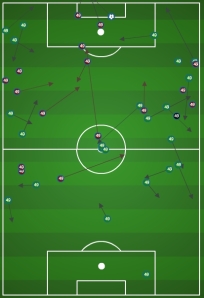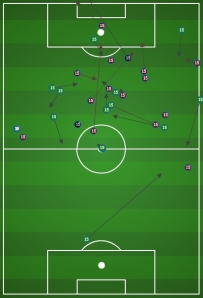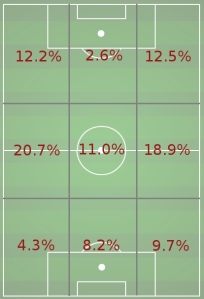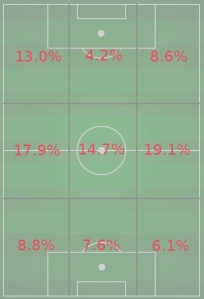The optimist looks at Real Salt Lake’s 2013 season and praises the club for making the MLS Cup Finals. The pessimist complains that they lost the MLS Cup Finals in penalty kicks despite holding a lead with 15 minutes remaining, facing a goalkeeper who seemed like his joints had frozen solid. The optimist praises the club’s performance in the U.S. Open Cup, lauding their run to the finals. The pessimist complains that they lost in the finals against DC United, a dreadful team. The optimist praises the team for finishing with a 16-10-8 record and a +16 goal differential in the regular season. The pessimist complains that they failed to win the Supporters Shield (again!) by 3 points. For Real Salt Lake in 2013, perception was everything.
2013 Finish: 16-10-8, 56 points; 57 GF, 41 GA. Second place in Western Conference. Lost in MLS Cup Finals.

Transactions
|
Players In
|
Players Out
|
| Name |
Pos |
|
Name |
Pos |
|
| Jordan Allen |
M/F |
Homegrown |
Yordany Alvarez |
M |
Out of Contract |
| Luke Mulholland |
M |
Free |
Brandon McDonald |
D |
Out of Contract |
| |
|
|
Josh Saunders |
GK |
Out of Contract |
| |
|
|
Khari Stephenson |
M |
Out of Contract |
| |
|
|
Lovel Palmer |
D/M |
Traded to Chicago |
Roster Churn: RSL returns 90.5% of its minutes played in 2013 (1st in all of MLS).
Know When to Hold ‘Em
In early 2013, Real Salt Lake owner Dell Loy Hanson made the decision not to extend Jason Kreis’s contract, gambling that Kreis’s stock would come down and he would be able to nab the coach at a bargain price. After all, the club had just lost Will Johnson, Jamison Olave, Fabian Espindola, and Jonny Steele in an offseason filled with cost-cutting moves. 2013 seemed likely to be a rebuilding year. Twelve months and two cup finals later, Jason Kreis is preparing for the 2015 debut of New York City FC, leaving Jeff Cassar, promoted from assistant coach, to lead Real Salt Lake. Cassar, with the team since 2007, is a safe choice, but even with all 11 starters returning, he may find it difficult to replicate the kind of success that RSL achieved under Jason Kreis.
In Good Hands
Nick Rimando returns to man the RSL nets for the 8th consecutive season. There’s nothing much that can be said about Rimando that you probably don’t already know. A 14-year veteran of the league, Rimando has ascended to third in command of the United States net. Remarkably, Rimando has a 10-0-0 record with the U.S. team, and is already tied for 5th all-time on the goalkeeper victory list with Brad Guzan.
Rimando’s national team opportunities have come as a result of stellar club play. Last season, he finished 2nd to Donovan Ricketts in Goalkeeper of the Year award voting, and was probably unlucky to do so. Rimando really is the total package: His reflexes and shot-stopping ability are legendary, and while it may not surprise you that Rimando finished 4th in pass completion percentage, the diminutive Rimando is also an excellent commander of his penalty area. In 2014, Rimando finished 4th in MLS in catches per 90 with 2.63. This paragraph is far too long for one that could have been summed up simply with "Real Salt Lake is in good hands with Nick Rimando."
Continuity in the Back
 With Chris Wingert, Nat Borchers, Chris Schuler, and Tony Beltran patrolling in front of him, Nick Rimando, too, will be in good hands. In the playoffs, Borchers and Schuler showed the potential to become one of the best pairings in the league. Though that is contingent on whether Schuler can remain healthy. In both the 2012 and 2013 seasons, Schuler was sidelined for multiple months with a foot injury. It was evident just how much Salt Lake missed Schuler last season when he was injured: with Schuler on the field last season, RSL conceded only 0.94 goals per 90, without him, they conceded 1.45 goals per 90. Yes, the sample size is small, and no, these numbers do not take into account opponent and location of the game. Still, Schuler’s contributions to defense were evident when 20-year old Carlos Salcedo was forced to step in. Nat Borchers provides much more certainty. In his 9-year Major League Soccer career (he spent two years with Odd Grenland in Norway), Borchers has averaged more than 28 starts per season.
With Chris Wingert, Nat Borchers, Chris Schuler, and Tony Beltran patrolling in front of him, Nick Rimando, too, will be in good hands. In the playoffs, Borchers and Schuler showed the potential to become one of the best pairings in the league. Though that is contingent on whether Schuler can remain healthy. In both the 2012 and 2013 seasons, Schuler was sidelined for multiple months with a foot injury. It was evident just how much Salt Lake missed Schuler last season when he was injured: with Schuler on the field last season, RSL conceded only 0.94 goals per 90, without him, they conceded 1.45 goals per 90. Yes, the sample size is small, and no, these numbers do not take into account opponent and location of the game. Still, Schuler’s contributions to defense were evident when 20-year old Carlos Salcedo was forced to step in. Nat Borchers provides much more certainty. In his 9-year Major League Soccer career (he spent two years with Odd Grenland in Norway), Borchers has averaged more than 28 starts per season.
 The Best Defense…
The Best Defense…
However, for all they do defensively, it may be their contributions to the attack that makes the RSL backline so valuable. Nat Borchers is one of the calmest defensive distributers in the league. Last season he had the 3rd best pass completion rate in the league, behind only Osvaldo Alonso and George John. This may be because Real Salt Lake puts a premium on possession and building the attack from the back, which sees Beckerman and the rest of the midfielders providing outlet options constantly. The team led MLS last season in possession percentage, pass success percentage, and percentage of passes that were under 25 yards. After all, Kwame Watson-Siriboe finished with a 93% passing rate (in but a mere handful of games), and Carlos Salcedo and Schuler both finished above 80%.
Wingert and Beltran involve themselves in the attack as well, though not always in the traditional, bomb-down-the-flanks-and-send-in-a-cross manner. When Real Salt Lake is in possession, the two outside backs (and Beltran especially) inhabit an advanced position on the field, where they can combine effectively with Gil, Grabavoy, Morales, and Saborio. Beltran is the more threatening of the two outside backs, finishing last season 5th in the league in key passes among defenders with 25.
Owning the Ball
The midfield will look awfully familiar for RSL fans this season as well, and why shouldn’t it? No midfield quartet in MLS can control the pace of the game like Kyle Beckerman, Ned Grabavoy, Luis Gil, and Javier Morales. Beckerman provides the transition from defense to attack, from left to right. He does it often, and he does it well. The only midfielder with more passes than Beckerman last season was Marcelo Sarvas, who had 3 more passes than Beckerman, though the Galaxy midfielder did it in 610 more minutes. Beckerman was the runaway leader in passes per game with 69.7, nearly 10 more than number two on the list. And though better known for his grit and tactical nous, Beckerman also manages to throw in no-look assists from time to time, just for fun (and to [almost] win MLS Cup).
Number two on that list of passes per game in MLS last year? None other than Javier Morales. Though he always has a target on his back, the 34-year-old Argentine playmaker often drifts wide and deep to ensure that he sees enough of the ball. And when he gets the ball, RSL benefits. Last season, Morales finished (per game) in the top 10 in fouls suffered (1st), key passes (2nd), successful through balls (4th), and successful crosses (6th).
These numbers are gaudy enough, but numbers like that are often indicative of a high-risk style of play, sending in large numbers of passes and crosses to in the hopes that a few of them will lead to dangerous scoring opportunities. And while he does send in a lot of passes (Morales has attempted [2,327] and completed [1,857] more passes in the opponent's half than any other MLS player over the last two years), what sets Morales apart from his peers is his effectiveness. While the average pass completion percentage of the rest of the top ten “key passers” (all attack-minded players) in 2013 was 76.6%, Morales’s was a hearty 83.1%. This number is inflated a bit both because he plays on such a talented, possession-oriented team and because he receives the ball farther from goal than, say, Thierry Henry or Robbie Keane, both of which lead to more safe ball touches. But even with these advantages, Morales should be regarded as one of the most talented players in the league, one who was unfortunate not to have been included in the MVP race last season.
The Other Guys
The rest of the midfield will be rounded out by two of the most underrated players in the league. Gil gets more publicity than Grabavoy. He did when he signed with Major League Soccer amid rumors of pursuit by clubs like Arsenal, and he does as a 20-year-old who has caught the eye of Jurgen Klinsmann. Gil deserves his plaudits, of course. After all, how many MLS players have played in 84 games before their 20th birthday? (By my count, just Freddy Adu and Eddie Gaven, though others, like Diego Fagundez, should get there).
But how many times have you heard Ned Grabavoy referenced recently? If you listen to the media or fans, probably not very many, but if you’re taking note of the play-by-play man on an RSL broadcast, you probably hear it quite often. Grabavoy is everywhere on the field: relentlessly pressuring the ball (he finished 14th last season in tackles per game among midfielders), and then quickly and efficiently--far more than he gets credit for (86% pass completion rate, 4th best in MLS)--distributing it. Remarkably, despite all of Grabavoy’s defensive grit, he finished tied for 6th among MLS midfielders in fouls suffered with 63 (9th in fouls per game with 2.0), and committed only 37 himself. If that’s not enough, he pitched in with 5 goals on only 29 shots, intelligently taking 20 shots inside the box versus only 9 outside.
The Finishers
Up top, Salt Lake will deploy their preferred pair of Alvaro Saborio and Robbie Findley. Saborio may be the most indispensable member on the RSL squad. He has scored at least 11 goals in each of the four seasons he has been in the league. Last season, due to injuries and international call-ups, he only managed 15 starts, yet still racked up 12 goals. His .80 goals per 90 minutes led the league.
Findley will provide support for Saborio. He may not have the greatest skill on the ball, but his pace down the channels draws defenders out of position and opens up space for Saborio and streaking midfielders. However, if Findley gets off to a slow start, he’ll have to watch his back. Last season, the trio of Olmes Garcia, Joao Plata, and Devon Sandoval, three very different types of forwards, all showed promise, and will be looking for even more playing time this season.
The Prediction
This preview has featured incessant, nearly sycophantic levels of praise for RSL players, but years of success despite shuttling players in and out of Utah to stay under the salary cap suggests that maybe it’s the system just as much as it is the players. After all, when Sebastian Velazquez filled in for Luis Gil, he looked great. Same for Yordany Alvarez for Ned Grabavoy. Joao Plata, Robbie Findley. Sandoval, Saborio. How much of the success of RSL was because of the system? How much of the system was based on Kreis’s presence?
American Soccer Analysis readers seem to think that the team will not have quite the same success this year. They have projected RSL to finish 4th in the Western Conference this season, with 20.69% of voters placing them there. Although very few people think that they will miss the playoffs entirely, with only 13.05% of voters placing them in spots six through nine.










